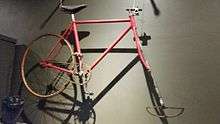Ice cycle
An ice cycle, ice bike, or icycle is a bicycle adapted for use on ice, usually by replacing the front wheel with an ice skate.[1][2][3][3][4][5] Versions exist with and without additional skates to provide lateral stability,[1][2] that have been based on upright and recumbent bikes,[6] and that have been used for racing.[3][6] Ice cycles have been in use since at least the 1890s,[7] and theory predicts that a bicycle with a front skate can exhibit riderless self-stability similar to the same bicycle with a front wheel.[8] At least one example has been made with both the front and the rear wheels replaced by skates.[9]

Icycle, a bicycle designed for riding on ice, at the History Museum at the Castle in Appleton, Wisconsin.

Icycle museum placard, at the History Museum at the Castle.
Gallery
 Front skate of Icycle
Front skate of Icycle Rear wheel of Icycle
Rear wheel of Icycle Icetrack bike
Icetrack bike
gollark: Or just don't write it.
gollark: Clever.
gollark: Oh, use it to obfuscate code to stop the unskilled programmers on the project from breaking it?
gollark: I don't agree with `Cat extends Animal`. You should just have a discriminated union of animals or something.
gollark: Except for OOP.
References
- Steve Casimiro (November 11, 2014). "The Icyclists". Adventure Journal. Archived from the original on November 25, 2015. Retrieved 2015-11-15.
- Milly Hurford (December 29, 2014). "Ice Bikes Add Appeal to Winter RidingForget fat bikes, there's a new winter cycling craze". Bicycling. Retrieved 2015-11-15.
- "New Ice-cycle Gives Cycling Thrills on Lakes in Winter (Apr, 1934)". Modern Mechanix. April 1934. Retrieved 2015-11-15.
- Kevin Paul Dupont (December 27, 2014). "In Buffalo, ice bikes are a cool ride". Boston Globe. Retrieved 2015-11-15.
- "Shifting Gears, A Cycling History of Badger Bicycling". November 4, 2015. Archived from the original on November 26, 2015. Retrieved November 25, 2015.
- Rosemary Peters (August 22, 2013). "Imperial alumnus skates towards success with new invention". Imperial College London. Retrieved 2015-11-15.
- "Ice Bicycle". Online Bike Museum. 1896. Retrieved 2015-11-15.
- J. D. G. Kooijman, J. P. Meijaard, J. M. Papadopoulos, A. Ruina, and A. L. Schwab (April 15, 2011). "A bicycle can be self-stable without gyrosocpic or caster effects" (PDF). Science. 332 (6027): 339–342. Bibcode:2011Sci...332..339K. doi:10.1126/science.1201959. PMID 21493856. Retrieved 2015-11-15.CS1 maint: uses authors parameter (link)
- "The History of Ice Biking and Winter Cycling: Swedish Iscykel". Icebike.org. Retrieved 2015-11-15.
This article is issued from Wikipedia. The text is licensed under Creative Commons - Attribution - Sharealike. Additional terms may apply for the media files.